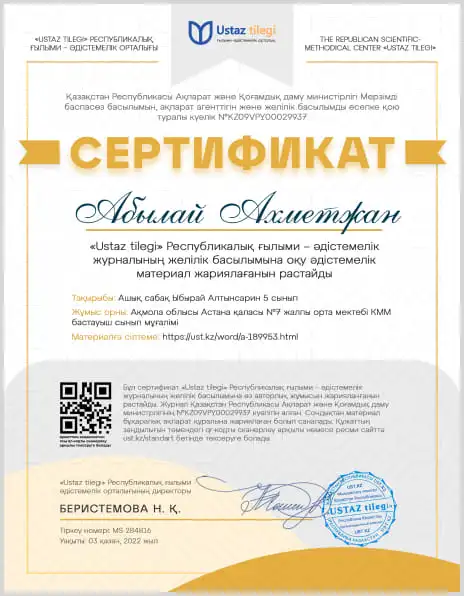Unit of a long term plan: Unit 3 Our Countryside. Lesson plan 28
| School: |
| Date: | Teacher's name:
|
| CLASS: 6 | Number present: | absent: |
| Lesson title | Animal behavior |
| Learning objectives(s) | 6.C1 use speaking and listening skills to solve problems creatively and cooperatively in groups ( Ex.1,2 p.36)6.S7 use appropriate subject-specific vocabulary and syntax to talk about a range of general topics, and some curricular topics ( Ex.3 p.36)6.L2 understand with little or no support most specific information in extended talk on a wide range of general and curricular topics( Ex.4 p.36)
|
| Lesson objectives |
1. Learn verbs for animal behavior.Жануарлардың мінез-құлқына арналған етістіктерді қолдана білу.2. Listen to an interview about animals and for general meaning and specific details. Жануарлар туралы әңгімелесуді және жалпы мағына мен нақты мәліметтерді тыңдаңыз.3. Speak about an animal and describe its behavior. Жануарлар туралы сөйлесіп, оның мінез-құлқын сипаттаңыз.
|
| Level of thinking | Higher order thinking skills (according to the revised Bloom's taxonomy). |
| Assessment criteria | 1. Жануарлардың мінез-құлқына арналған етістіктерді қолданып дұрыс сөйлем құрастырады.2. Жануарлар туралы деректі тыңдап түсінеді.3. Жануарлардың мінез-құлқы туралы сипаттайды. |
| Target language | Beaver, dam, salmon ,chase, enormous, hole, move. |
| Values links | Appreciating the love to animals |
| Cross-curricular links | Natural Science, Social Science, History, Geography |
| Previous learning | Learners knew about animals Learners knew animal’s groupLearners knew Domestic and wild animals. |
| Plan |
| Planned timings | Planned activities (replace the notes below with your planned activities) | Resources |
Start
2 min
2 min
4 min | The lesson greeting.The teacher sets the lesson objectives, letting students know what to anticipate from the lesson.Warm up. Let’s stand in a circle and wishes to each other.Training: Divide class 2 groups: 1 group- Domestic animals2 group- Wild Animals Pre-learningWrite affirmative and negative sentences.
Teacher elicits the knowledge of making question rule and helps learners to remember the rules for making affirmative and negative sentences with Present Continuous.Brainstorming:Match definitions 1-7 with words a-g1. When an animal gives food to its babies A.Build2. When people run after an animals and kill it for food or sport. B. Feed3. When an animal make a house or something new. C. fight 4. When two animals are angry they do this. D. Hunt5. When an animal makes a big hole. E. Eat6. When an people do something good and make an animal’s life easier. F.dig 7. When an animal puts food in its mouth. G. Help-Good job children! -How do you think our today’s new theme?-Ok. Very good. ( assess students with smiles)Yes, today our new lesson “Animals behaviour”Aims of the new lesson:
| Slide (objectives)
Slide (useful phrases)
Writing Worksheets
Interactive board
|
Main part7 min
5 min
10 min
7 min | The main part of the lesson. Strategy:
The consolidation of the theme about animals.Each group will give a short information about their animals.Descriptor: 1. Choose the number.2. Give characteristic of the animal. So, what can animals do? Write as many activities as you know?What is it doing?Make as many sentences as you can. Begin your sentences “I think…”. I think that a monkey is funny.I think that a snake is dangerous.I think that a parrot is speaking.I think that a falcon is hunting.I think that a frog lives in the water.I think that a fly is tiny.I think that owls sleep during the day.I think that a tortoise hides in its shell.I think that a butterfly is interesting and they are flying,they like flower. They life is short. I think that a whale is the biggest ocean animal. They are sleeping. They are strong.-That’s right.
Ex. 1. P. 36Check the meaning of the verbs in bold. Then look at photos 1-6 and choose the correct verbs:Ex. 1 - p.36(activity of animals)What six animals can you see on page 36? Descriptor: 1. Look at the photos.2. Choose the correct verbs.Check their answer;1. feeding 2. Building 3. Catching 4. Protecting 5. Hunting 6. Chasing Assessment criteria: Peer assessment5-6- “excellent”3-4- “Good”1-2-“Satisfy”Listen to the text: While listening, do also Ex.4.Descriptor:1. Listen text attentively.2. Put the words in correct order.1. two 2. Fly 3. 25 4.two 5. Fish 6. travelsAssessment criteria: Peer assessment5-6- “excellent”3-4- “Good”1-2-“Satisfy”(GW)Descriptor:1. Choose an animal.2. Describe the animal behavior.3. Make a poster.Group assessment:Assessment criteria:1. How big is the animal?2. Where does it live?3. Where does it eat?4. How does it move?-Good job! You are so active today.
|
WhiteboardA table
A presentation " Wild animals".
Writing Worksheets
Writing Worksheets
Pictures
CD 1.31Student's Book p.36 |
End5 min
| Home task. Exercise 2. p.36FeedbackSuccess treeGreen leaf – I totally understandYellow leaf – I understand the lesson but I need some helps.Red leaf – I don’t understand |
|
| Additional information |
| Differentiation – how do you plan to give more support? How do you plan to challenge the more able learners? | Assessment – how are you planning to check learners’ learning? | Health and safety check |
Differentiation can be achieved through content (Based on the theory of Multiple Intelligences different tasks are used with the same text).By support:Less able learners will be supported through step-be-step instructions, glossaries, thinking time. By task:For more able learners additional leveled tasks are offered.
| Assessment criteria:Read the given passage and identify the general information. Demonstrate skills of organizing and expressing ideas accurately.Descriptors:A learnerreads the text for global understanding;selects meaningful information, constructs the answer;presents information in the group discussion.evaluates the peers’ answers.Teacher's observation using observation checklist Self-assessment.
| Health saving technologies.
|




